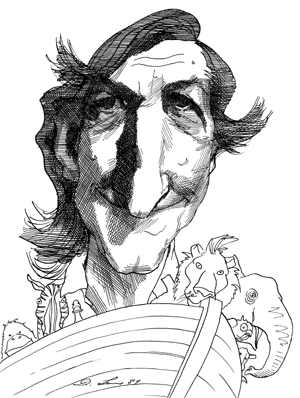The new work of fiction by Julian Barnes is his fifth since 1981, and about as much entitled to the name of a “novel” as to the name of A History of the World. Like its predecessor, Flaubert’s Parrot, it is a novel in deep disguise. Setting aside the matter of titles, a reader who picks up this new book will find it to consist of ten or eleven short stories, mostly sardonic in tone, written with meticulous point, at a temperature not far from zero centigrade. Several are connected with one another, thematically if not by narrative links; they create, if not a history, then a vision of the world. There’s a fair bit of factual material woven into the prevailing fantasy, a good bit of impersonation in different voices, a couple of relatively straight narrations, and also something like a rhapsody. It’s a book to keep the reader on his toes.
Woodworms, for which the popular name is furniture beetles, the learned title Anobium domesticum, provide one unlikely skein of the narrative. Seven of the little bugs—one literate—are understood to have stowed away on Noah’s ark. The one articulate (and in fact quite erudite) coleopter provides a strikingly disabused view of the voyage; from this narrative neither Noah nor any of his offspring, nor for that matter the Deity, emerges with the slightest shred of credit. In fact the insect-narrator combines very agreeably a condescending view of the human race’s congenital ineptitudes with a kind of resentful whine, altogether befitting his station in life.
The story he tells, naturally from his own point of view behind the wainscoting, is pretty much that familiar from Genesis 6–9, though he is careful to point out where the human race, to serve its private ends, has prettified details. One is glad to have made his acquaintance and at the end of his narrative, to send him along. But he links in an indirect and perhaps significant way with another community of woodworms who are protagonists of another story. These insects, dating from approximately the Middle Ages, are being sued in an ecclesiastical court and stand in peril of excommunication. Their crime is that they ate through á leg of the Bishop of Besançon’s throne with deleterious consequences for the Bishop’s noddle. Despite the forceful pleas of learned counsel, the insectioles are found guilty and condemned to an annual penance which, by an ingenious and characteristic maneuver, they triumphantly circumvent.
Well, so much for woodworms, though a few scattered ones turn up throughout the rest of the volume. But Noah’s ark recurs several times, first in an ugly little story of cowardice in the face of terror aboard a cruise ship in the Aegean, then in the story of a determined nineteenth-century English lady’s visit to Ararat in search of the ark (she arrives just in time to view the catastrophic earthquake of 1840, but succumbs to the rigors of the district). Then, about a century later, an American ex-astronaut is bitten by the same bug, and sets off to Ararat in search of the ark (in a cave he finds Noah’s bones, which are of course those of the English lady). No woodworms here, but the theme of the ark, inverted and transposed, may perhaps be recognized in a couple of other tales. One summarizes the story of “The Raft of the Medusa,” best known from Géricault’s dramatic painting; another is the odyssey of a somewhat battered Australian lady who is scared by the imminence of atomic warfare into stealing a boat and drifting off into the empty spaces of the Arafura Sea until she is rescued and learns that the bombs haven’t fallen and aren’t immediately likely to.
Kath Ferris, who does much hallucinating on her long drift around the ocean, provides a good illustration of Barnes’s tough, shifty style. Her interlocutor is a medical man who may be an open-sea delusion or a doctor in the hospital after she’s picked up:
I’ll give you an example. I’m quite cunning in my nightmares. When the men come I pretend not to be surprised. I act as if it’s normal that they should be there. I call their bluff. Last night we had the following exchange. Make of it what you will.
“Why am I wearing white gloves?” I asked.
“Is that what you think they are?”
“What do you think they are?”
“We had to put a drip in your arm.”
“Is that why I have to wear white gloves? This isn’t the opera.”
“They aren’t gloves. They’re bandages.”
“I thought you said I had a drip in my arm.”
“That’s right. The bandages are to hold the drip in place.”
“But I can’t move my fingers.”
“That’s normal.”
“Normal?” I said. “What’s normal nowadays?” He couldn’t find an answer to that, so I carried on. “Which arm is the drip in?”
“The left. You can see that for yourself.”
“Then why have you bandaged my right arm as well?”
He had to think about that for a long time. Finally he said, “Because you were trying to pull the drip out with your free hand.”
“Why should I want to do that?”
“I should think only you can tell us.”
I shook my head. He went away defeated. But I gave as good as I got, didn’t I?
The ark story comes back several times, given different tones and emphases, sometimes reduced to nothing more than the act of drifting. The horrifying account of the “rescue ship” St. Louis, which in 1939 picked up nearly a thousand German Jewish refugees bound for America and, after tantalizing them with a glimpse of freedom, returned them to the European holocaust, could be a malign version of Noah’s original navigation.
Advertisement
Thus the several units of Barnes’s collection can be threaded together, but that they make up units of the book would be too much to say. The book is its own unit, held together by its own acerb, ironic vision. The “heroes,” or most of them, are a pretty scruffy lot. The gutless tour director on the hijacked ship comes out of the same batch as the wenching movie actor writing from the depths of a South American jungle to his proper girlfriend in London.
By and large the articulate woodworm of the first story is not far off in his estimate of the human race. Perhaps the female characters come off a little better than the males in this collection, but not by much, and they are rarely more than victims. Victims or victimizers, Barnes’s personae all carry about them the air of specimens—metaphorically speaking, they trail a whiff of formaldehyde. The pleasures of the book derive less from them than from the skills of their creator. Barnes writes with a quiet, disillusioned wit and a special gift for change of pace that sometimes makes his prose crack like a whip.
Indeed, it’s the writing that holds the book together, the thematic parallels that break it apart. The parenthesis or rhapsody, for instance, is a venture into lyrical monologue, spoken, apparently, by Julian Barnes, referring to himself by name, but it slides off into a preacherly, and probably semiserious lecture on love that teeters on the edge of a Leo Buscaglia abyss. Yet from time to time there’s a haunting resemblance to the woodworm of the first story, and when the speaker repeats a distinctive passage from that first story, the effect is not far from eerie.
Such are the diversions of Barnes’s sharply written and carefully calculated book. No one would call it a “good yarn,” or a “soul-searching experience”; the clichés don’t apply. Barnes is an accomplished equilibrist; a reader who appreciates being made to work for his sense of balance will find in A History of the World special pleasures, special perils.
This Issue
October 26, 1989




